Fast Cable-Force Measurement for Large-Span Cable-Stayed Bridges Based on the Alignment Recognition Method and Smartphone-Captured Video
Abstract
:1. Introduction
2. Basic Principle of Cable-Force Measurement
2.1. Dynamic Response Evaluation Using Alignment Recognition Method
- The cable segment in all images is assumed to be straight, that is, sag is not considered.
- In the monochrome images, the cable has a similar grayscale intensity along the axial direction, and there is usually a sufficient intensity difference between the cable and the image background.
- In the images, the part of the cable to be studied should traverse from the left side to the right side.
2.2. Cable-Force Estimation Based on the Frequency Test Method
2.3. Computational Procedure
- Acquire videos of the stay cables using high-precision image-capture equipment or UAV remote sensing technology, then convert them into image data of the stay cable;
- Rely on digital image-processing technology to identify and extract the cable line shape, thereby obtaining line-shape data and the geometric coordinates of spatial points. By comparing with the initial images, obtain the dynamic displacement of the target points in the region of interest (ROI).
- Use the central finite-difference approximation method to numerically differentiate the dynamic displacement to obtain the cable’s acceleration time history.
- Derive the relationship between cable force and parameters such as natural frequency, bending stiffness, support conditions, and concentrated mass based on the dynamic equation of beam elements.
- Substitute the identified natural frequency of the cable and the relevant geometric and physical parameters into Equation (11) to calculate the corresponding cable force.
3. Gengcun Dou Bridge and Health Monitoring System
3.1. Description of Gengcun Dou Bridge
3.2. Structural Health Monitoring System
4. Experimental Validation
4.1. Results of Dynamic Response Evaluation
4.2. Results of Cable-Force Measurement
5. Conclusions
- (1)
- By comparing the acceleration data collected by the monitoring system, the cable dynamic-response assessment method proposed in this paper can accurately capture the frequency components in the acceleration response. The identified relative error of the first-order natural frequency of the cable does not exceed 3.0%. The dynamic response measurements at different positions of the same cable are consistent. During the measurement process, an appropriate region of interest (ROI) can be selected based on the relationship between the environmental background and the target object to perform the cable-force measurement.
- (2)
- The actual measurement results of the cable force from the on-site monitoring system have verified the accuracy and stability of the method proposed in the paper. The average relative deviation of the actual measured cable force does not exceed 3.0%, and the maximum relative deviation does not exceed 4.0%. Two symmetrically positioned cables were extracted for comparative analysis, and the trend of cable-force changes of the two cables was consistent. This indicates that the method proposed in the paper can effectively measure the trend in cable-force changes in long-span bridges.
- (3)
- The cable-force measurement method has been applied to the operation and maintenance phase of the Gengcun Dou Bridge for cable-force monitoring, achieving rapid measurement of cable forces for large-span bridge structures. This method has a clear principle and simple installation, providing a novel method for the actual measurement of cable forces in large-span bridge structures. It can offer reliable cable-force monitoring data for structural status analysis during the operation and the maintenance phase.
Author Contributions
Funding
Data Availability Statement
Conflicts of Interest
References
- Li, H.; Ou, J. The State of the Art in Structural Health Monitoring of Cable-Stayed Bridges. J. Civ. Struct. Health Monit. 2016, 6, 43–67. [Google Scholar] [CrossRef]
- Brownjohn, J.M.W. Structural Health Monitoring of Civil Infrastructure. Philos. Trans. R. Soc. A Math. Phys. Eng. Sci. 2007, 365, 589–622. [Google Scholar] [CrossRef] [PubMed]
- Kim, B.H.; Park, T. Estimation of Cable Tension Force Using the Frequency-Based System Identification Method. J. Sound Vib. 2007, 304, 660–676. [Google Scholar] [CrossRef]
- Cho, S.; Yim, J.; Shin, S.W.; Jung, H.-J.; Yun, C.-B.; Wang, M.L. Comparative Field Study of Cable Tension Measurement for a Cable-Stayed Bridge. J. Bridge Eng. 2013, 18, 748–757. [Google Scholar] [CrossRef]
- Duan, Y.F.; Zhang, R.; Dong, C.Z.; Luo, Y.Z.; Or, S.W.; Zhao, Y.; Fan, K.Q. Development of Elasto-Magneto-Electric (EME) Sensor for In-Service Cable Force Monitoring. Int. J. Struct. Stab. Dyn. 2016, 16, 1640016. [Google Scholar] [CrossRef]
- Yao, Y.; Yan, M.; Bao, Y. Measurement of Cable Forces for Automated Monitoring of Engineering Structures Using Fiber Optic Sensors: A Review. Autom. Constr. 2021, 126, 103687. [Google Scholar] [CrossRef]
- Zheng, R.; Liu, L.; Zhao, X.; Chen, Z.; Zhang, C.; Hua, X. Investigation of Measurability and Reliability of Adhesive-Bonded Built-in Fiber Bragg Grating Sensors on Steel Wire for Bridge Cable Force Monitoring. Meas. J. Int. Meas. Confed. 2018, 129, 349–357. [Google Scholar] [CrossRef]
- Li, X.X.; Ren, W.X.; Bi, K.M. FBG Force-Testing Ring for Bridge Cable Force Monitoring and Temperature Compensation. Sens. Actuators A Phys. 2015, 223, 105–113. [Google Scholar] [CrossRef]
- Fu, W.W.; Luo, Y.Z.; Wan, H.P.; Shen, Y.B.; Li, J.L.; Chen, L.M. Research on a Cable Force Measurement Method of National Speed Skating Oval Based on Surface Strain. China Civ. Eng. J. 2022, 55, 91–96. [Google Scholar]
- Kim, S.T.; Park, Y.; Park, S.Y.; Cho, K.; Cho, J.-R. A Sensor-Type PC Strand with an Embedded FBG Sensor for Monitoring Prestress Forces. Sensors 2015, 15, 1060–1070. [Google Scholar] [CrossRef]
- Zhou, Y.S.; An, P.; Cao, J.J.; Zhang, J.N.; Liu, C. Design of By-Pass Excitation Cable Force Sensor. J. Phys. Conf. Ser. 2019, 1267, 12068. [Google Scholar] [CrossRef]
- Haji Agha Mohammad Zarbaf, S.E.; Norouzi, M.; Allemang, R.; Hunt, V.; Helmicki, A.; Venkatesh, C. Vibration-Based Cable Condition Assessment: A Novel Application of Neural Networks. Eng. Struct. 2018, 177, 291–305. [Google Scholar] [CrossRef]
- Sim, S.H.; Li, J.; Jo, H.; Park, J.W.; Cho, S.; Spencer, B.F.; Jung, H.J. A Wireless Smart Sensor Network for Automated Monitoring of Cable Tension. Smart Mater. Struct. 2014, 23, 025006. [Google Scholar] [CrossRef]
- Amabili, M.; Carra, S.; Collini, L.; Garziera, R.; Panno, A. Estimation of Tensile Force in Tie-Rods Using a Frequency-Based Identification Method. J. Sound Vib. 2010, 329, 2057–2067. [Google Scholar] [CrossRef]
- Fang, Z.; Wang, J.Q. Practical Formula for Cable Tension Estimation by Vibration Method. J. Bridge Eng. 2012, 17, 161–164. [Google Scholar] [CrossRef]
- Zuo, D.; Jones, N.P. Interpretation of Field Observations of Wind- and Rain-Wind-Induced Stay Cable Vibrations. J. Wind Eng. Ind. Aerodyn. 2010, 98, 73–87. [Google Scholar] [CrossRef]
- Li, X.; Huang, X.; Ding, P.; Wang, Q.; Wang, Q. Research on an Intelligent Identification Method for Cable-Stayed Force with a Damper Based on Microwave Radar Measurements. Buildings 2024, 14, 568. [Google Scholar] [CrossRef]
- Yu, S.; Zhang, J.; Su, Z.; Jiang, P. Fast and Robust Vision-Based Cable Force Monitoring Method Free from Environmental Disturbances. Mech. Syst. Signal Process. 2023, 201, 110617. [Google Scholar] [CrossRef]
- Zhang, L.; Qiu, G.; Chen, Z. Structural Health Monitoring Methods of Cables in Cable-Stayed Bridge: A Review. Meas. J. Int. Meas. Confed. 2021, 168, 108343. [Google Scholar] [CrossRef]
- Weng, J.; Chen, L.; Sun, L.; Zou, Y.; Liu, Z.; Guo, H. Fully Automated and Non-Contact Force Identification of Bridge Cables Using Microwave Remote Sensing. Meas. J. Int. Meas. Confed. 2023, 209, 112508. [Google Scholar] [CrossRef]
- Zhao, X.; Han, R.; Yu, Y.; Hu, W.; Jiao, D.; Mao, X.; Li, M.; Ou, J. Smartphone-Based Mobile Testing Technique for Quick Bridge Cable–Force Measurement. J. Bridge Eng. 2017, 22, 06016012. [Google Scholar] [CrossRef]
- Ye, X.W.; Que, W.M.; Ding, Y.; Jin, T. Fast Force Estimation of Cable Structures Using Smartphone-Captured Video and Template Matching Algorithm. Struct. Control Health Monit. 2024, 2024, 5512085. [Google Scholar] [CrossRef]
- Du, W.; Lei, D.; Bai, P.; Zhu, F.; Huang, Z. Dynamic Measurement of Stay-Cable Force Using Digital Image Techniques. Meas. J. Int. Meas. Confed. 2020, 151, 107211. [Google Scholar] [CrossRef]
- Kim, S.W.; Cheung, J.H.; Park, J.B.; Na, S.O. Image-Based Back Analysis for Tension Estimation of Suspension Bridge Hanger Cables. Struct. Control Health Monit. 2020, 27, e2508. [Google Scholar] [CrossRef]
- Feng, D.; Scarangello, T.; Feng, M.Q.; Ye, Q. Cable Tension Force Estimate Using Novel Noncontact Vision-Based Sensor. Meas. J. Int. Meas. Confed. 2017, 99, 44–52. [Google Scholar] [CrossRef]
- Chen, C.-C.; Tseng, H.-Z.; Wu, W.-H.; Chen, C.-H. Modal Frequency Identification of Stay Cables with Ambient Vibration Measurements Based on Nontarget Image Processing Techniques. Adv. Struct. Eng. 2012, 15, 929–942. [Google Scholar] [CrossRef]
- Chu, C.; Ghrib, F.; Cheng, S. Cable Tension Monitoring through Feature-Based Video Image Processing. J. Civ. Struct. Health Monit. 2021, 11, 69–84. [Google Scholar] [CrossRef]
- Tian, Y.; Zhang, C.; Jiang, S.; Zhang, J.; Duan, W. Noncontact Cable Force Estimation with Unmanned Aerial Vehicle and Computer Vision. Comput. Civ. Infrastruct. Eng. 2021, 36, 73–88. [Google Scholar] [CrossRef]
- Li, S.; Cao, Z.; Li, J.; Li, P.; Xu, B.; Gao, W. Complex Background Removal Method for Video of an Inclined Cable Based on UAV Detection of Structural Vibration Frequencies. Struct. Control Health Monit. 2024, 2024, 1630928. [Google Scholar] [CrossRef]
- Deng, L.; Yan, W.C.; Li, S.F. Computer Modeling and Weight Limit Analysis for Bridge Structure Fatigue Using OpenSEES. J. Bridge Eng. 2019, 24, 4019081. [Google Scholar] [CrossRef]
- Jiang, T.; Frøseth, G.T.; Rønnquist, A.; Fagerholt, E. A Robust Line-Tracking Photogrammetry Method for Uplift Measurements of Railway Catenary Systems in Noisy Backgrounds. Mech. Syst. Signal Process. 2020, 144, 106888. [Google Scholar] [CrossRef]
- Canny, J. A Computational Approach to Edge Detection. IEEE Trans. Pattern Anal. Mach. Intell. 1986, PAMI-8, 679–698. [Google Scholar] [CrossRef]
- Grompone von Gioi, R.; Jakubowicz, J.; Morel, J.-M.; Randall, G. LSD: A Line Segment Detector. Image Process. Line 2012, 2, 35–55. [Google Scholar] [CrossRef]
- Jana, D.; Nagarajaiah, S.; Yang, Y. Computer Vision-Based Real-Time Cable Tension Estimation Algorithm Using Complexity Pursuit from Video and Its Application in Fred-Hartman Cable-Stayed Bridge. Struct. Control Health Monit. 2022, 29, e2985. [Google Scholar] [CrossRef]
- Fan, G.; Li, J.; Hao, H. Improved Automated Operational Modal Identification of Structures Based on Clustering. Struct. Control Health Monit. 2019, 26, e2450. [Google Scholar] [CrossRef]
- Ren, W.-X.; Zong, Z.-H. Output-Only Modal Parameter Identification of Civil Engineering Structures. Struct. Eng. Mech. 2004, 17, 429–444. [Google Scholar] [CrossRef]
- Ren, W.X.; Chen, G.; Hu, W.H. Empirical Formulas to Estimate Cable Tension by Cable Fundamental Frequency. Struct. Eng. Mech. 2005, 20, 363–380. [Google Scholar] [CrossRef]
- Xu, M.; Xu, Q.; Zeng, B.; Li, J.Z. Unified Presumption Formula for Estimating Cable Force by Frequency Test Method Considering Service Characteristics. J. Build. Struct. 2023, 44, 456–473. [Google Scholar]


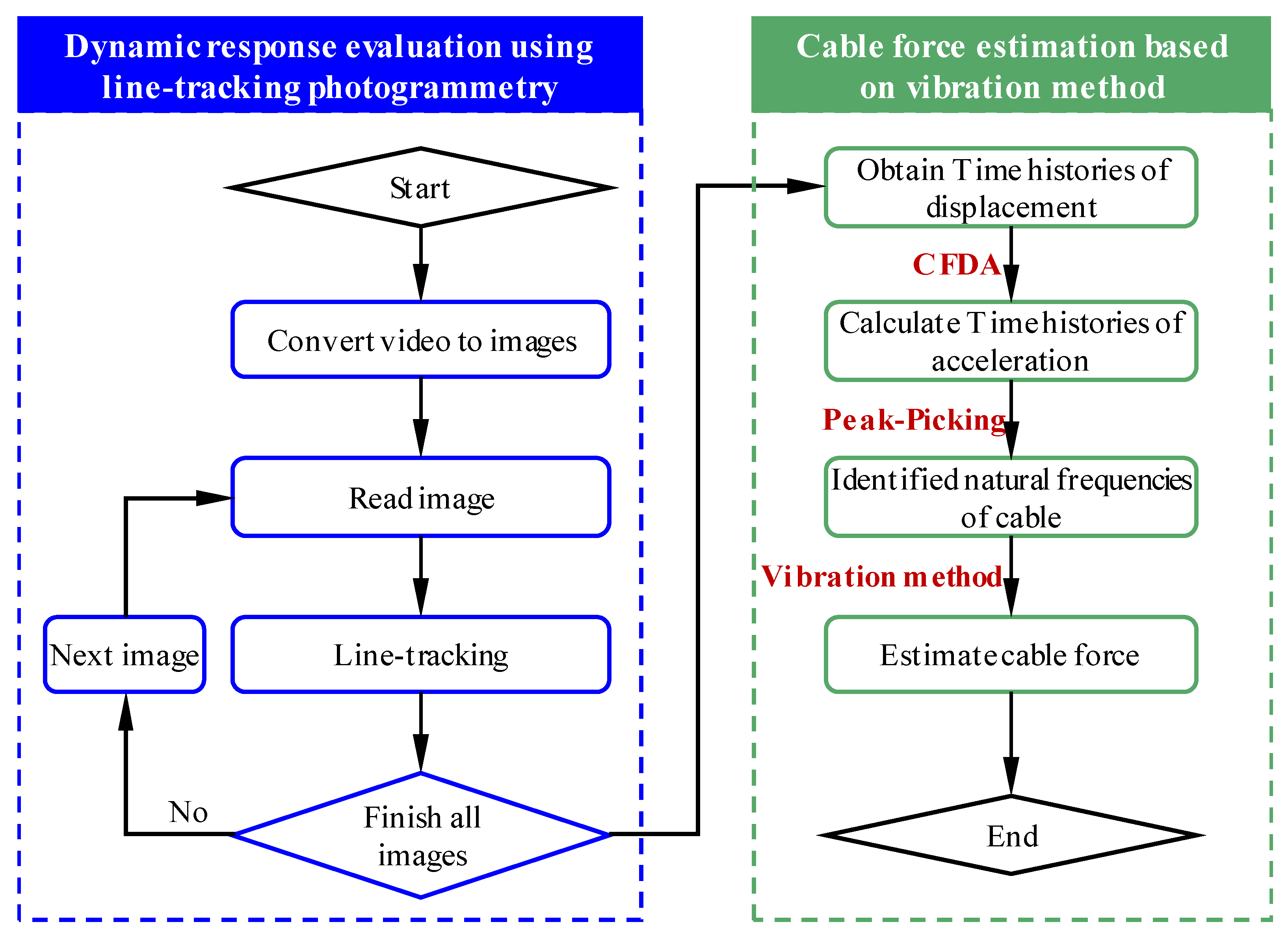
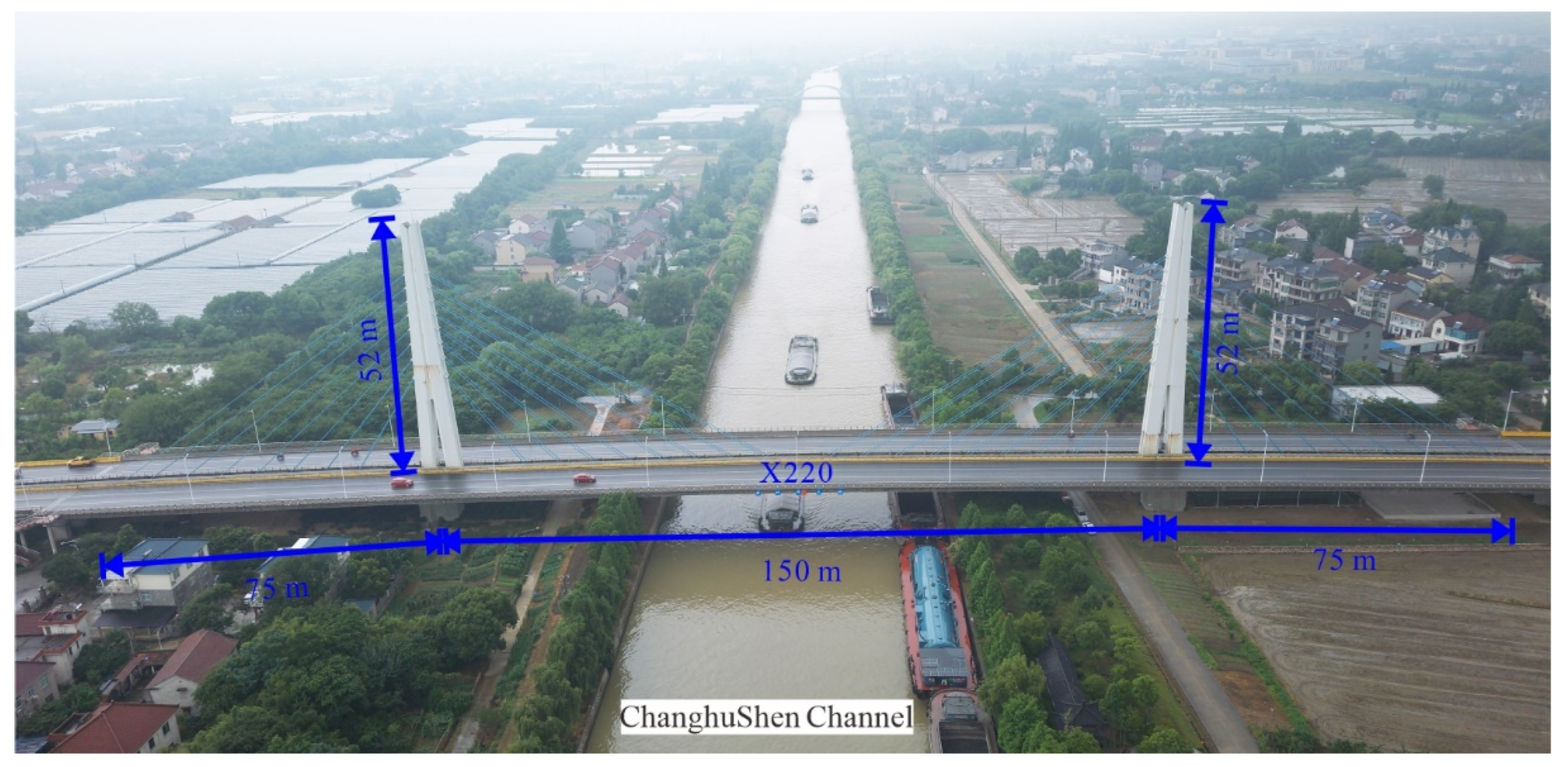

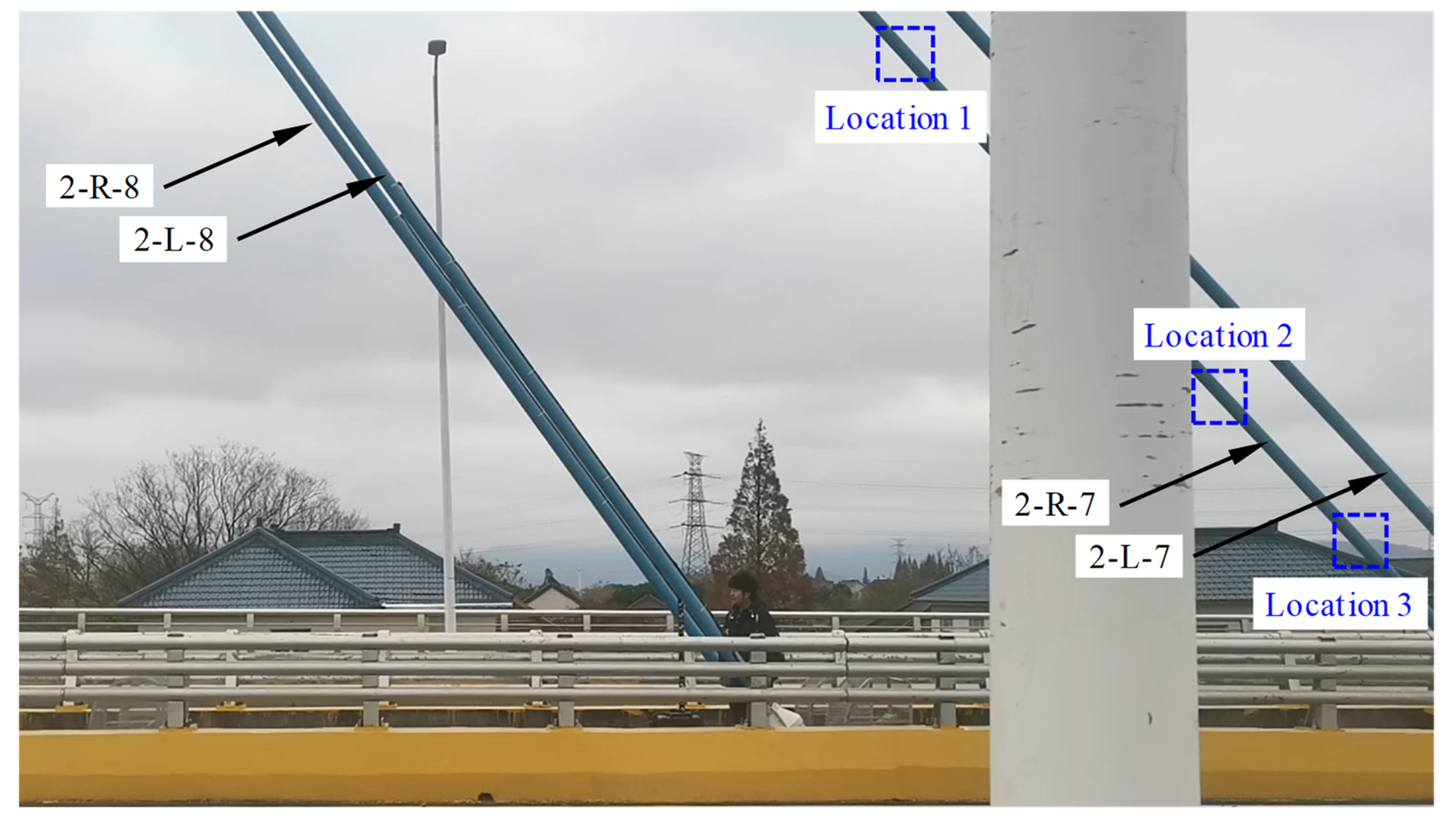
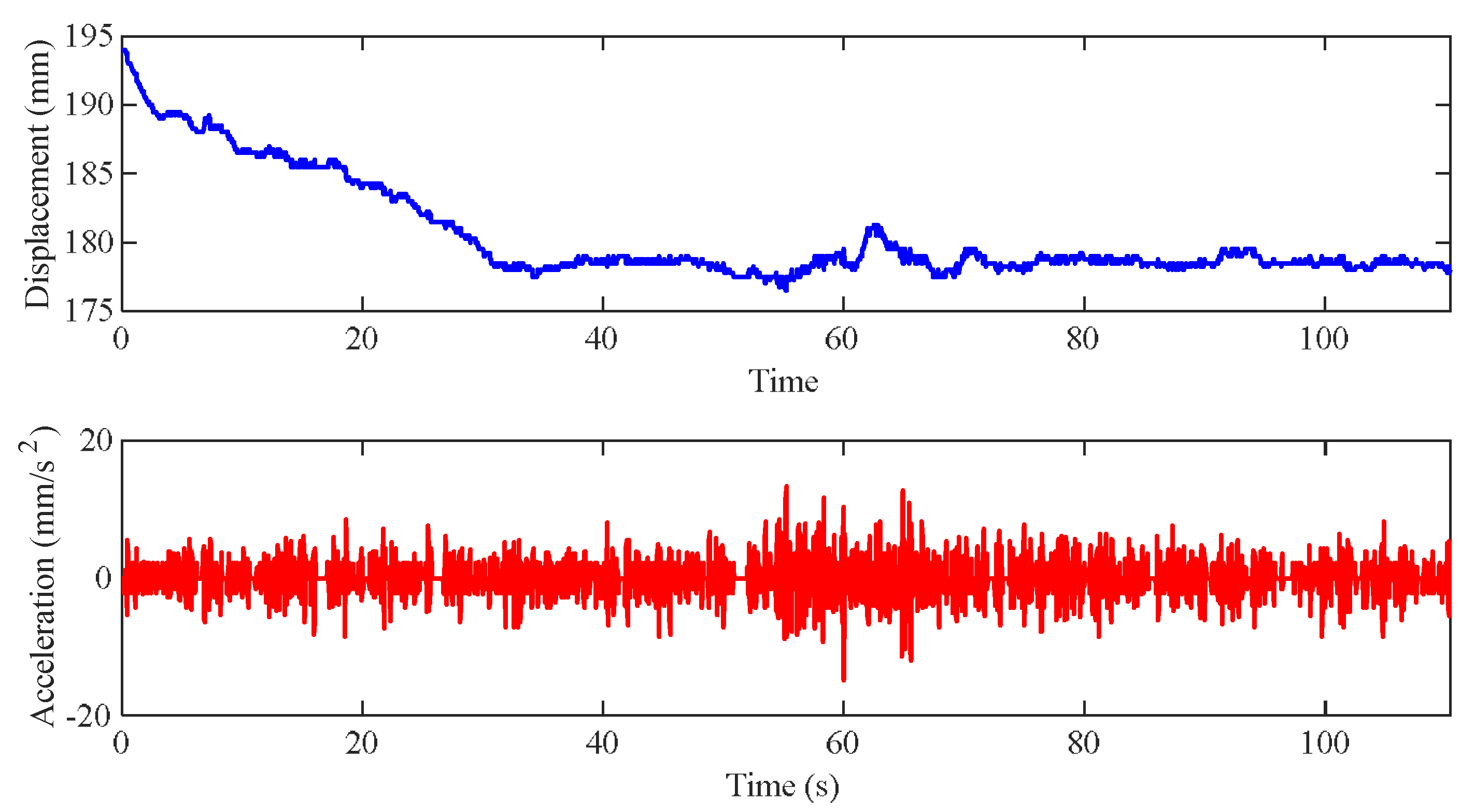
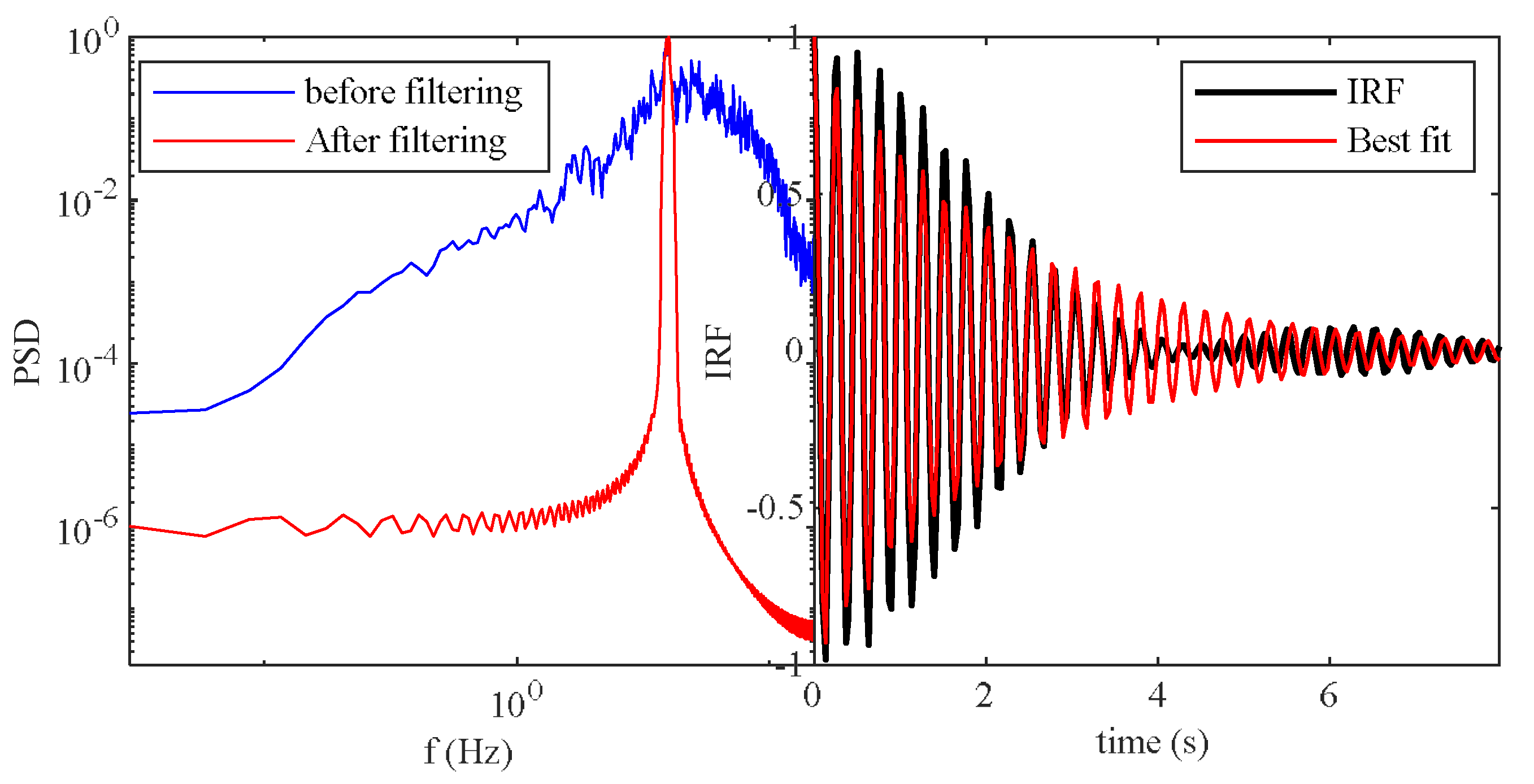

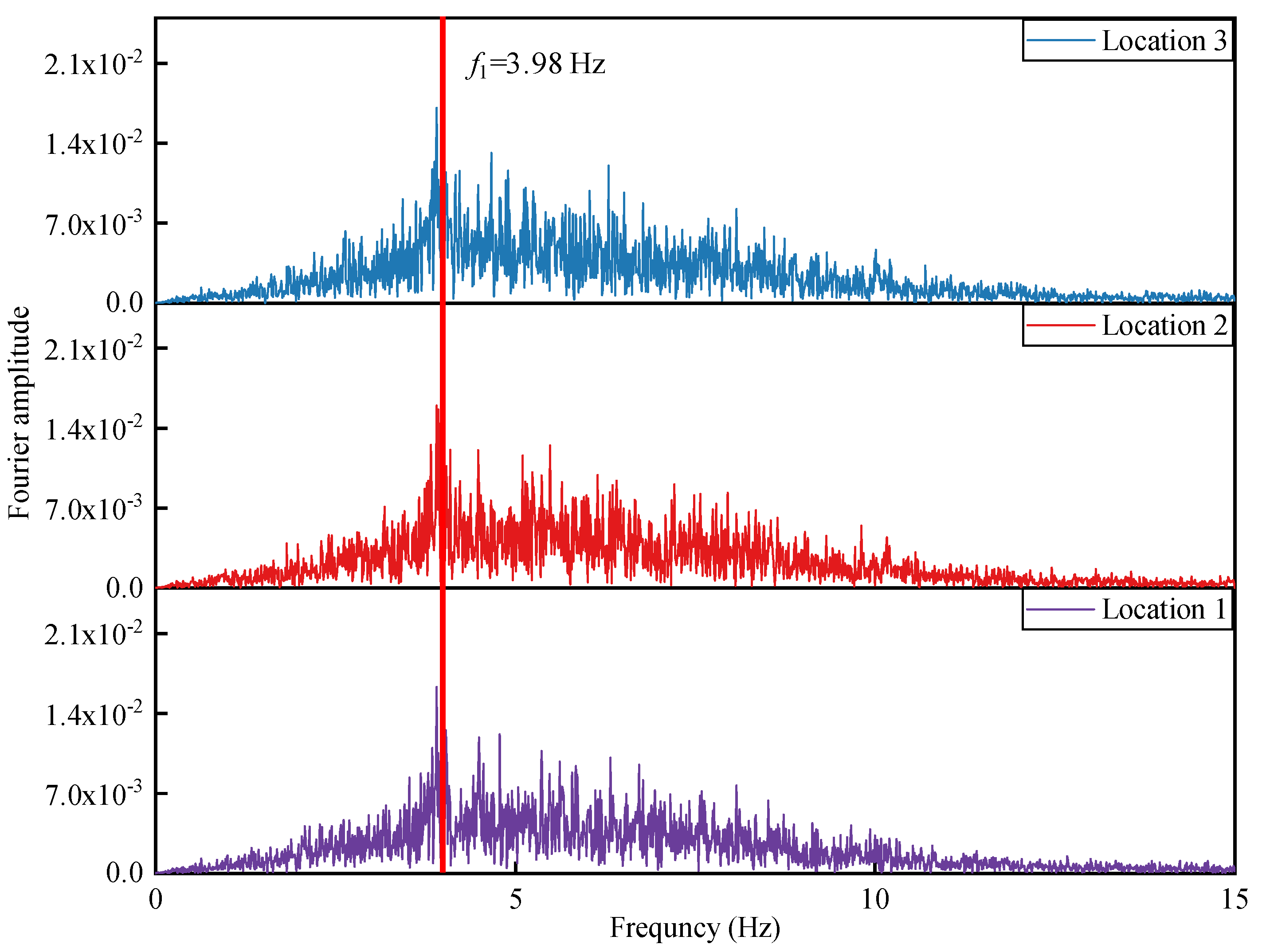
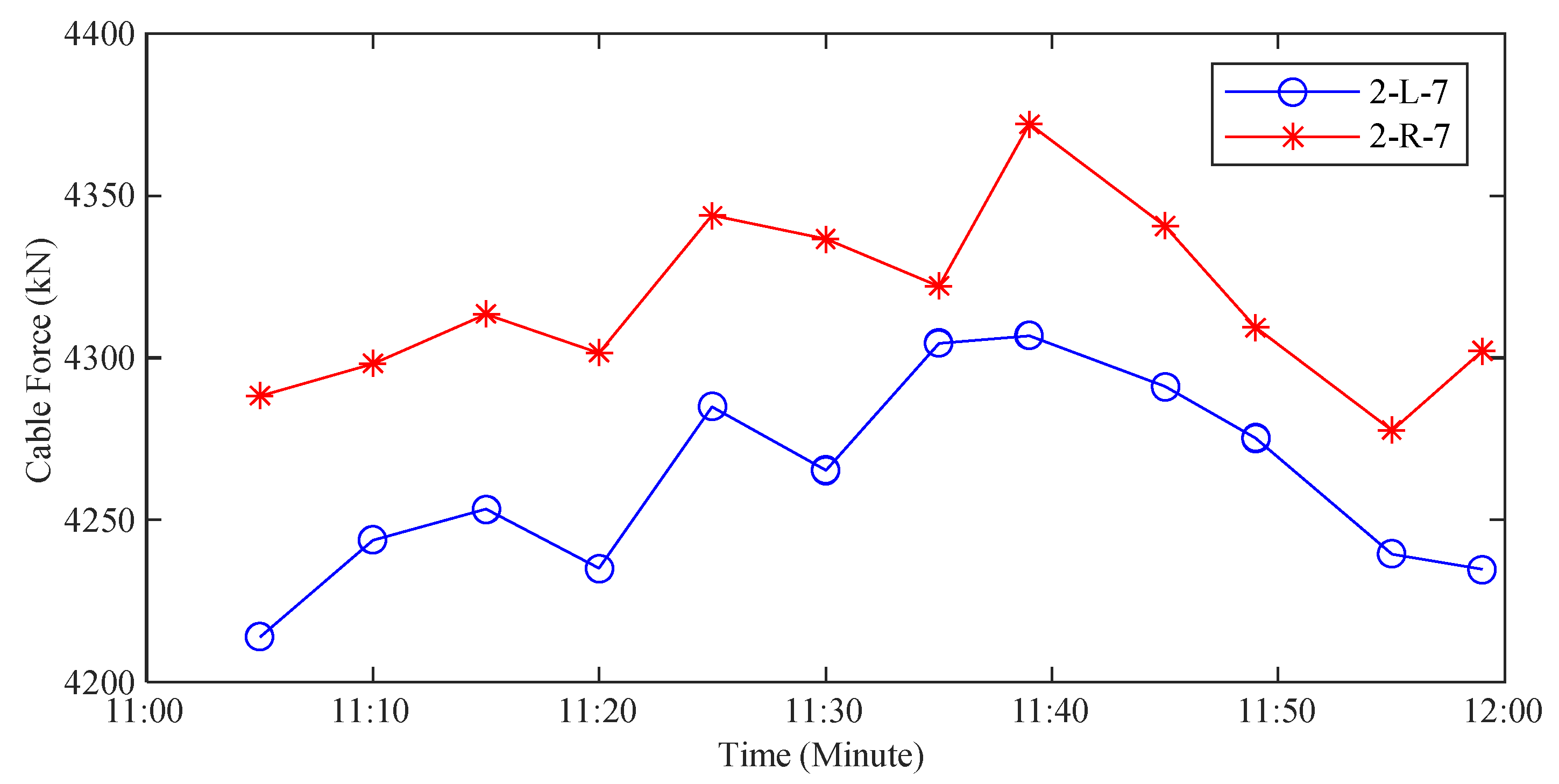
| Boundary Conditions | Raito of Cable Length and Diameter | Characteristic Parameters | |
|---|---|---|---|
| μ1 | μ2 | ||
| Hinged | 50 < ψ ≤ 150 | 4 | π2 |
| Ψ > 150 | 4 | 0 | |
| Fixed | 50 < ψ ≤ 150 | 3.94 | −61.62 |
| Ψ > 150 | 3.94 | 0 | |
| No. | Type | Effective Length (m) | Mass per Unit Length (kg/m) | Axial Stiffness (KN) |
|---|---|---|---|---|
| 1-L-1 | PESM 7-187 | 79.45 | 56.29 | 4979 |
| 1-L-2 | PESM 7-187 | 73.19 | 56.29 | 4897 |
| 1-L-3 | PESM 7-187 | 65.35 | 56.29 | 4875 |
| 1-L-4 | PESM 7-187 | 57.56 | 56.29 | 4809 |
| 1-L-5 | PESM 7-187 | 49.87 | 56.29 | 4749 |
| 1-L-6 | PESM 7-187 | 42.27 | 56.29 | 4705 |
| 1-L-7 | PESM 7-187 | 34.78 | 56.29 | 4621 |
| 1-L-8 | PESM 7-187 | 27.39 | 56.29 | 4579 |
| Serial Number | Diameter (mm) | Effective Length (m) | Mass per Unit Length (kg/m) | Axial Stiffness (kN) |
|---|---|---|---|---|
| 2-L-7 | 95.7 | 34.78 | 56.29 | 4621 |
| 2-R-7 | 95.7 | 34.78 | 56.29 | 4621 |
| 2-L-8 | 95.7 | 27.39 | 56.29 | 4579 |
| 2-R-8 | 95.7 | 27.39 | 56.29 | 4579 |
| Serial Number | Estimated Cable Force (kN) | Differences in Estimation | |
|---|---|---|---|
| Image-Based | Sensor-Based | ||
| 2-L-7 | 4256.5 | 4377.6 | −2.77% |
| 2-R-7 | 4312.7 | 4357.6 | −1.03% |
| 2-L-8 | 4580.8 | 4706.5 | −2.67% |
| 2-R-8 | 4856.7 | 4695.6 | 3.43% |
Disclaimer/Publisher’s Note: The statements, opinions and data contained in all publications are solely those of the individual author(s) and contributor(s) and not of MDPI and/or the editor(s). MDPI and/or the editor(s) disclaim responsibility for any injury to people or property resulting from any ideas, methods, instructions or products referred to in the content. |
© 2024 by the authors. Licensee MDPI, Basel, Switzerland. This article is an open access article distributed under the terms and conditions of the Creative Commons Attribution (CC BY) license (https://creativecommons.org/licenses/by/4.0/).
Share and Cite
Lu, H.; Fu, W.; Chen, Y.; Li, B.; Li, Y. Fast Cable-Force Measurement for Large-Span Cable-Stayed Bridges Based on the Alignment Recognition Method and Smartphone-Captured Video. Buildings 2024, 14, 1941. https://doi.org/10.3390/buildings14071941
Lu H, Fu W, Chen Y, Li B, Li Y. Fast Cable-Force Measurement for Large-Span Cable-Stayed Bridges Based on the Alignment Recognition Method and Smartphone-Captured Video. Buildings. 2024; 14(7):1941. https://doi.org/10.3390/buildings14071941
Chicago/Turabian StyleLu, Hongxia, Wenwei Fu, Yi Chen, Bingchun Li, and Yang Li. 2024. "Fast Cable-Force Measurement for Large-Span Cable-Stayed Bridges Based on the Alignment Recognition Method and Smartphone-Captured Video" Buildings 14, no. 7: 1941. https://doi.org/10.3390/buildings14071941






